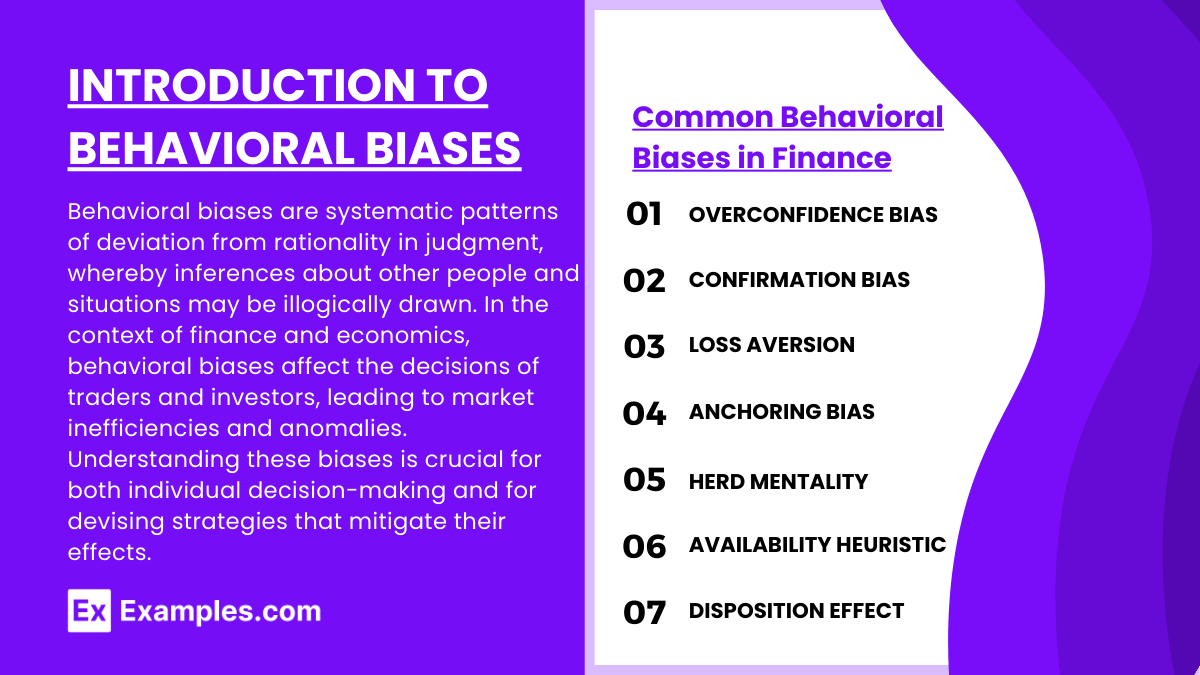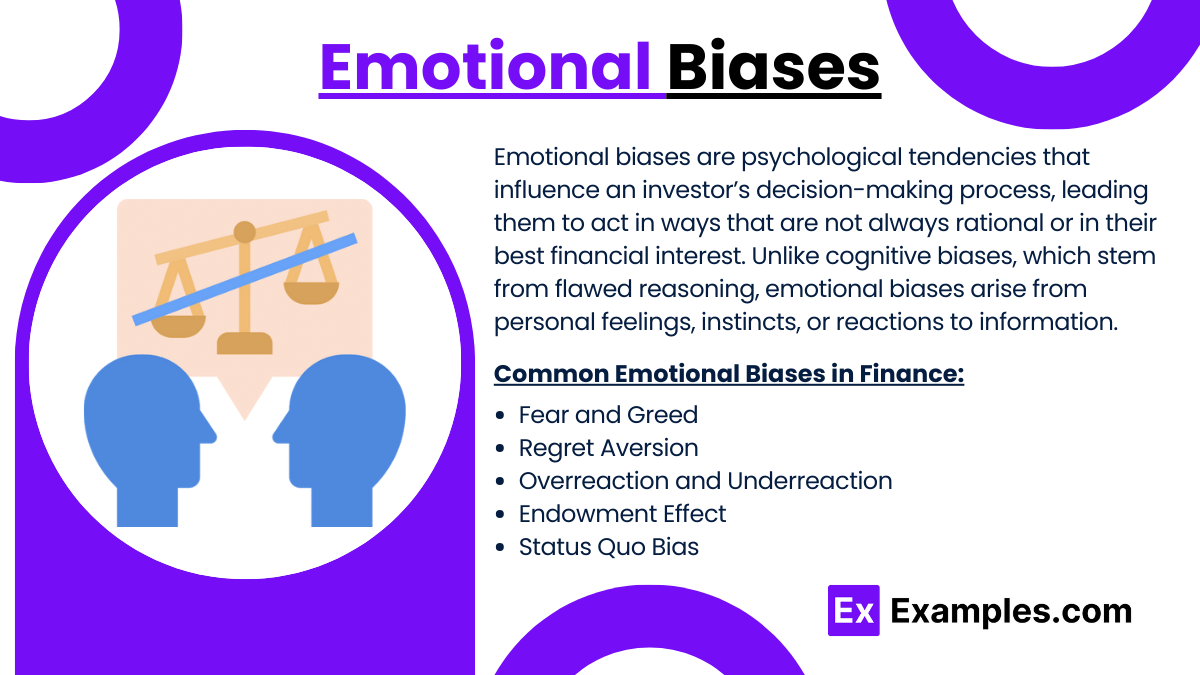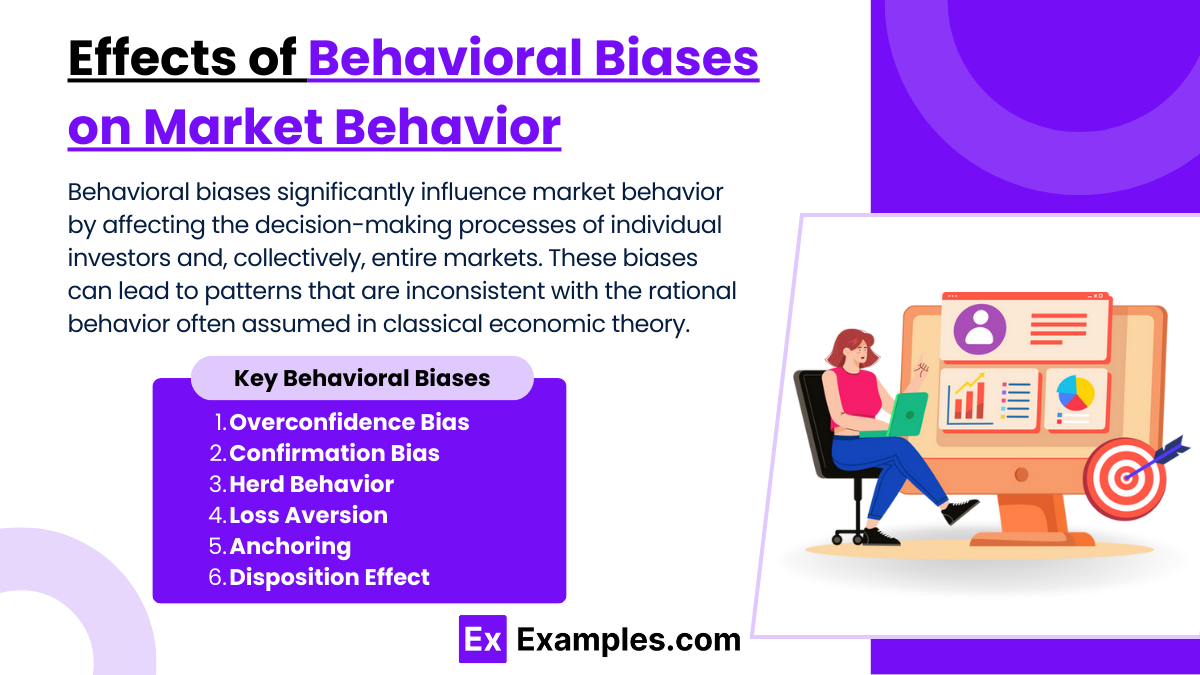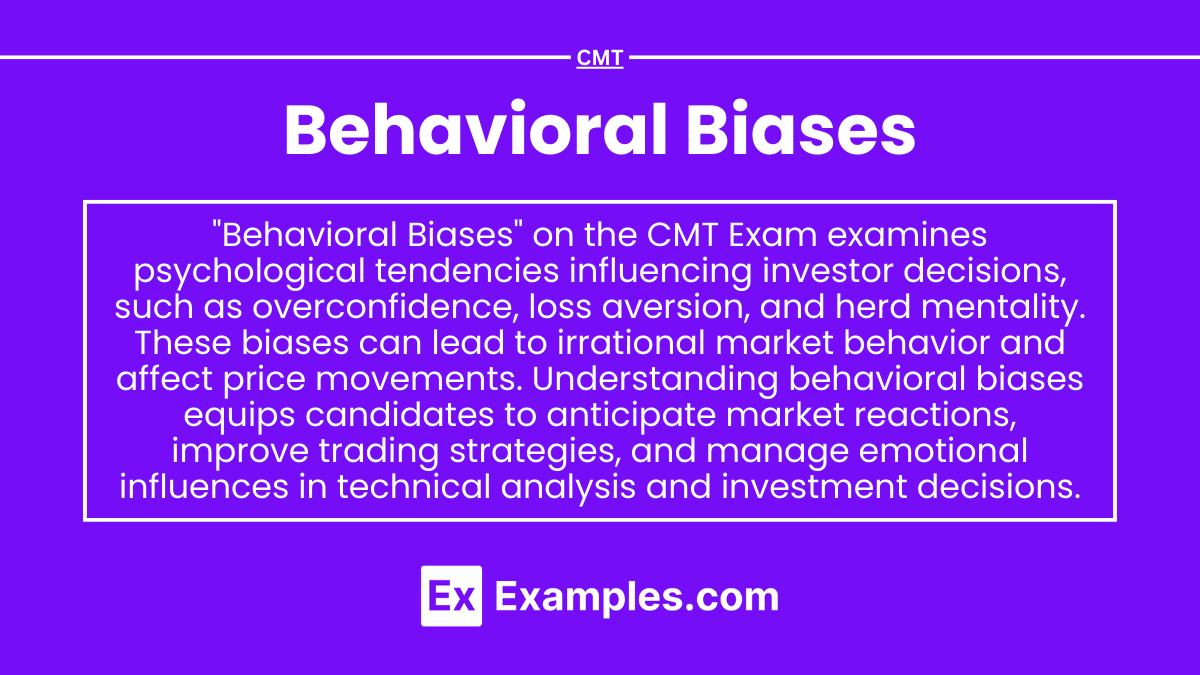Preparing for the CMT Exam requires a comprehensive understanding of “Behavioral Biases,” a crucial component of behavioral finance. Mastery of how cognitive and emotional factors influence investor decisions is essential. This knowledge provides insights into market anomalies, investor behavior, and risk assessment, critical for achieving a high CMT score.
Learning Objective
In studying “Behavioral Biases” for the CMT Exam, you should learn to understand the psychological factors that influence investor behavior and decision-making in financial markets. Analyze how cognitive biases like overconfidence, anchoring, and confirmation bias impact trading and investment strategies. Evaluate the effects of emotional biases such as loss aversion and herd mentality on market dynamics. Additionally, explore how these biases can lead to systematic patterns and anomalies in financial markets. Apply this knowledge to identify opportunities and risks in trading, enhance portfolio management, and develop strategies that mitigate the effects of irrational behavior in market participants.
Introduction to Behavioral Biases

Behavioral biases are systematic patterns of deviation from rationality in judgment, whereby inferences about other people and situations may be illogically drawn. In the context of finance and economics, behavioral biases affect the decisions of traders and investors, leading to market inefficiencies and anomalies. Understanding these biases is crucial for both individual decision-making and for devising strategies that mitigate their effects. Here’s an introduction to key behavioral biases that commonly influence financial decisions:
Common Behavioral Biases in Finance
- Overconfidence Bias
- Individuals overestimate their knowledge, abilities, and access to information, leading to overtrading and poor investment decisions.
- Confirmation Bias
- Investors seek out information that confirms their existing beliefs and ignore contradictory information, which can result in holding onto losing investments for too long.
- Loss Aversion
- The pain of losing is psychologically about twice as powerful as the pleasure of gaining. Investors may irrationally hold losing positions to avoid realizing a loss or sell winning positions too quickly to lock in gains.
- Anchoring Bias
- Decisions are overly influenced by initial information that serves as an “anchor,” regardless of its relevance. For example, an investor might focus too heavily on the initial purchase price of a stock rather than its current market conditions.
- Herd Mentality
- Individuals follow the actions of a larger group, independently of their own knowledge or judgment. This can create asset bubbles or exacerbate market crashes.
- Availability Heuristic
- Investors estimate the probability of an event based on how easily an example can be recalled, often leading to a misjudgment of actual risks involved.
- Disposition Effect
- The tendency to sell assets that have increased in value while keeping assets that have dropped in value, which can be detrimental to achieving the benefits of a buy-and-hold strategy.
Cognitive Biases in Investment Decisions

Cognitive biases are systematic patterns of deviation from norm or rationality in judgment, where individuals make illogical decisions influenced by their preconceived notions and feelings. In the context of investment decisions, cognitive biases can lead to suboptimal financial outcomes, such as buying high, selling low, holding onto losing stocks too long, or failing to correctly diversify portfolios. Here’s an exploration of some key cognitive biases that affect investment decisions and how they manifest in the financial markets:
Key Cognitive Biases in Investment:
- Confirmation Bias: Investors may ignore conflicting information, leading to holding on to losing investments.
- Overconfidence Bias: An inflated belief in one’s own intuition or judgment can lead to excessive risk-taking.
- Loss Aversion: The fear of losses leads to holding losing investments too long, hoping to recover losses rather than cutting them.
- Anchoring Bias: Investors might anchor on the initial purchase price of a stock, affecting sell or buy decisions irrespective of current market realities.
- Herd Mentality: Following the crowd without independent analysis can lead to bubbles or crashes.
- Availability Heuristic: Making decisions based on easily recalled information rather than comprehensive data, skewing risk assessment.
Emotional Biases

Emotional biases are psychological tendencies that influence an investor’s decision-making process, leading them to act in ways that are not always rational or in their best financial interest. Unlike cognitive biases, which stem from flawed reasoning, emotional biases arise from personal feelings, instincts, or reactions to information. Here’s a discussion of some common emotional biases and their impact on financial markets:
Common Emotional Biases in Finance:
- Fear and Greed
- Fear: Often causes investors to sell assets prematurely during market downturns to avoid further losses, potentially missing the recovery.
- Greed: Leads investors to take on excessive risk in the pursuit of high returns, particularly during bullish markets, often resulting in losses when market conditions change.
- Regret Aversion
- Investors avoid taking decisive investment actions due to the fear of making a wrong decision that leads to regret, especially if a similar decision led to poor outcomes in the past. This can result in missed opportunities or failure to correct mistakes.
- Overreaction and Underreaction
- Overreaction: Investors may excessively react to bad news, causing stock prices to fall more than is justified by fundamentals.
- Underreaction: Conversely, good news may take time to be fully reflected in stock prices, as investors initially underreact.
- Endowment Effect
- Investors value assets they already own more highly than those they do not own, merely because they own them. This can lead to holding onto stocks or other assets longer than is economically beneficial.
- Status Quo Bias
- This bias leads investors to prefer to keep things the same by doing nothing or maintaining their current or previous decisions rather than making a change, even when that change might be beneficial.
Effects of Behavioral Biases on Market Behavior

Behavioral biases significantly influence market behavior by affecting the decision-making processes of individual investors and, collectively, entire markets. These biases can lead to patterns that are inconsistent with the rational behavior often assumed in classical economic theory. Here’s an overview of how various behavioral biases impact market behavior:
Key Behavioral Biases and Market Impacts:
- Overconfidence Bias
- Leads to excessive trading and increased market volatility as investors overestimate their knowledge and decision-making abilities.
- Confirmation Bias
- Causes slow incorporation of new information into market prices, leading to prolonged mispricing of securities.
- Herd Behavior
- Can create asset bubbles or lead to sudden market crashes as investors mimic others’ actions without independent analysis.
- Loss Aversion
- Increases market volatility and leads to price underreactions, as investors are reluctant to realize losses and eager to realize gains.
- Anchoring
- Affects price adjustment processes, causing resistance to moving away from historical reference points, such as past price levels.
- Disposition Effect
- Contributes to the momentum anomaly in stock returns, leading to the premature sale of winning assets and prolonged holding of losing ones.
Examples
Example 1: Overconfidence in Day Trading
An individual investor frequently engages in day trading, driven by overconfidence in his market analysis and trading skills. Despite a track record of mixed results, his belief in his ability to time the market precisely leads to excessive trading and higher transaction costs, ultimately diminishing his overall returns.
Example 2: Anchoring on Entry Price
A portfolio manager buys a stock at $100, which then declines to $80. Despite new information suggesting further decline, the manager holds onto the stock, anchored to the $100 entry price, hoping to break even rather than cutting losses based on the new valuation.
Example 3: Herd Behavior During Market Bubbles
During the dot-com bubble, many investors, influenced by herd behavior, continued to buy overvalued tech stocks simply because others were buying and stock prices were rising. This collective irrationality contributed to the bubble, which eventually burst, leading to significant financial losses.
Example 4: Loss Aversion in Portfolio Management
An investor refuses to sell an underperforming asset to avoid realizing a loss, despite clear signs that reallocating the funds to a more promising investment would likely improve her portfolio’s performance. This loss aversion bias prevents optimal portfolio rebalancing.
Example 5: Confirmation Bias in Financial Analysis
A financial analyst issues a buy recommendation for a stock and continues to focus only on positive news and data that support his initial analysis, disregarding emerging negative indicators. This confirmation bias can lead to poor investment decisions based on incomplete or selective information.
Practice Questions
Question 1
Which behavioral bias is characterized by an investor’s tendency to hold losing investments too long and sell winning investments too soon?
A. Overconfidence
B. Herd behavior
C. Loss aversion
D. Anchoring
Answer:
C. Loss aversion
Explanation:
Loss aversion is a common behavioral bias where investors are so averse to realizing a loss that they hold onto losing investments in hopes of a rebound rather than accepting the loss and reallocating resources more effectively. Conversely, they may sell winning investments prematurely to lock in gains, potentially missing out on further profits.
Question 2
What does herd behavior in the financial markets describe?
A. The tendency of investors to trade too frequently based on technical signals
B. The inclination of investors to follow the majority or popular market trends without independent analysis
C. The practice of basing investment decisions solely on historical financial statements
D. The habit of selecting stocks based on quantitative algorithms only
Answer:
B. The inclination of investors to follow the majority or popular market trends without independent analysis
Explanation:
Herd behavior refers to the phenomenon where individuals in a group tend to think and behave in similar ways, influenced by emotion or a desire to conform, rather than relying on their independent analysis. In financial markets, this can lead to irrational exuberance or unjustified market sell-offs.
Question 3
How does confirmation bias potentially affect an investor’s decision-making process?
A. It leads an investor to seek information that confirms their existing beliefs, ignoring contradictory evidence.
B. It causes investors to diversify their portfolios excessively.
C. It encourages investors to base their decisions on well-documented financial theories.
D. It drives investors to frequently switch investment strategies based on market conditions.
Answer:
A. It leads an investor to seek information that confirms their existing beliefs, ignoring contradictory evidence.
Explanation:
Confirmation bias is a cognitive bias that involves favoring information that conforms to one’s existing beliefs and disregarding information that contradicts them. This can lead to flawed decision-making as investors might ignore warning signs or negative data, potentially resulting in poor investment choices based on incomplete or selective analysis.


